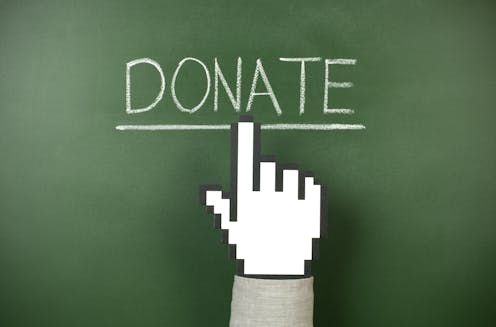Making a difference without millions – how Americans give
- Written by Thalia Plata, Editorial Intern

Can everyday people make a difference in their communities without millions of dollars? Lucy Bernholz[1], a senior research scholar at Stanford University’s Center on Philanthropy and Civil Society, believes that philanthropy is far more multifaceted than wealthy individuals writing checks to nonprofit organizations.
“Most books written about philanthropy [talk] about rich people,” said Bernholz, “and I wanted to know what was happening with everyone else.”
Bernholz shared her research and knowledge on how people participate in acts of charitable giving during a webinar hosted by The Associated Press, The Chronicle of Philanthropy and The Conversation U.S., called “Making a difference without millions – How Americans give.”
The panel also featured Tiffani Ashley Bell, executive director of The Human Utility; Maria Smith Dautruche, director of the Westchester Center for Racial Equity; and Sara Lomelin, executive director of Philanthropy Together. The panelists shared how they give and the power of community philanthropy. Watch the video below to hear the entire dicussion.
Panelists Tiffani Ashley Bell, Lucy Bernholz, Maria Smith Dautruche and Sara Lomelin joined Eden Stiffman, senior editor at the Chronicle of Philanthropy, to discuss how American are giving today.What is philanthropy?
According to Bernholz, people are always encountering requests to give – whether you’re on your commute to work, running errands downtown, helping a neighbor, at the register of a drugstore or just checking social media. Bernholz calls these occurrences “the givingscape,” “which are all these opportunities to give time, money and data.”
Nonprofit organizations are just one part of what makes up philanthropy. “They have certain benefits. And certain drawbacks,” Bernholz said. She believes that in order to achieve true equity and justice, charitable giving to nonprofits should not be seen as the only way to give.
Her work, including her latest book, “How We Give Now[2]”, re-imagines what philanthropy looks like and tries to understand how average people create, fund and distribute shared social goods in the digital age.
Giving in the digital age
The digital age hasn’t revolutionized philanthropy but instead has brought attention to old behaviors and moral ideals, Bernholz said. While things like mutual aid programs might seem new, Bernholz believes that it’s the same type of community participation people have always been drawn to doing.
“For my book, [my team and I] interviewed people who said, I contribute to the same effort to repair my neighbor’s house from the flood, but if they hit me with a GoFundMe [request], I’m actually going to walk over there and hand them the cash,” Bernholz said. “The sense of connection, community and identity is what drives folks to give.”
Bernholz argues that the digitization of giving[3] has increased the need for accountability and transparency in philanthropy. She points to the fact that crowdsourcing apps like Venmo, PayPal and Cash App are not required to report their data.
“We rely on these companies to tell us how much [money] they’ve moved, because we can’t see the data. They don’t have to tell us. So we can see the [crowdsourcing], but we don’t actually have the details,” she said.
Data as a charitable donation?
While the lack of data from companies concerns Bernholz, she believes that deliberate acts of sharing data are a part of “the givingscape.”
“For example, [people who] take their digital photographs or digitize their family albums and contribute them as a conscious deliberate choice to an archive of [historical events],” Bernholz said. “We can build archives and actually uncover or reveal incredibly important parts of the complicated history of this country.”
Data sharing, according to Bernholz, has had an “enormous effect” on efforts to protect biodiversity.
“Because so many people now have phones with cameras, [they can take a photo of a bird or bug] while out on a walk or hike and can upload it to a particular app and add it to a biodiversity database,” she said.
Bernholz still believes that sharing data should be approached with caution. Efforts must be taken to ensure that “people from different backgrounds, different experiences with data [and] different experiences of structural harm set the parameters for whether and how we should do that.”
[Get the best of The Conversation’s politics, science or religion articles each week.Sign up today[4].]
References
- ^ Lucy Bernholz (pacscenter.stanford.edu)
- ^ How We Give Now (mitpress.mit.edu)
- ^ digitization of giving (theconversation.com)
- ^ Sign up today (memberservices.theconversation.com)
Read more https://theconversation.com/making-a-difference-without-millions-how-americans-give-172960

















